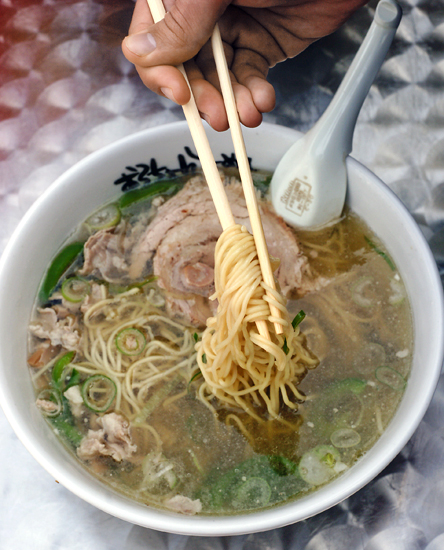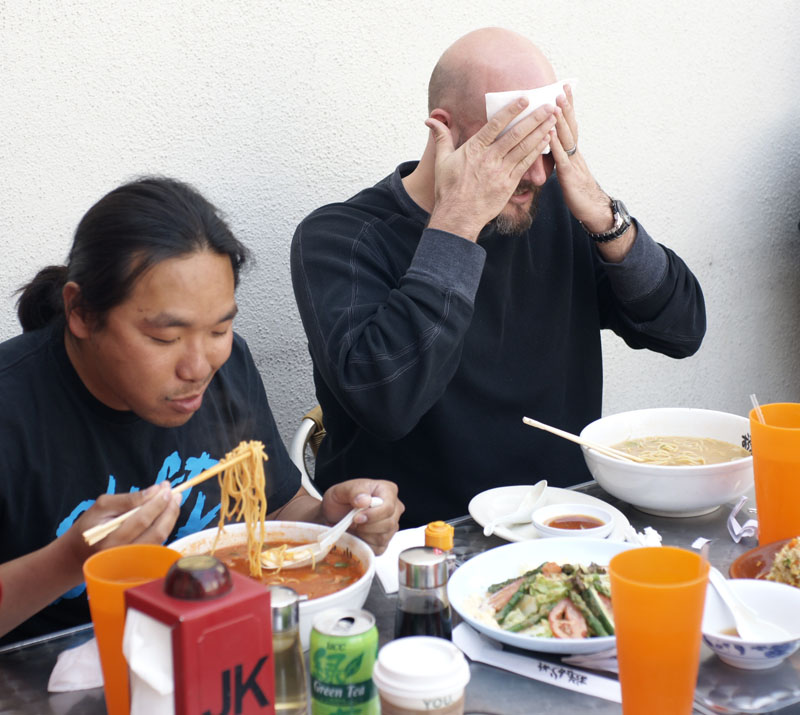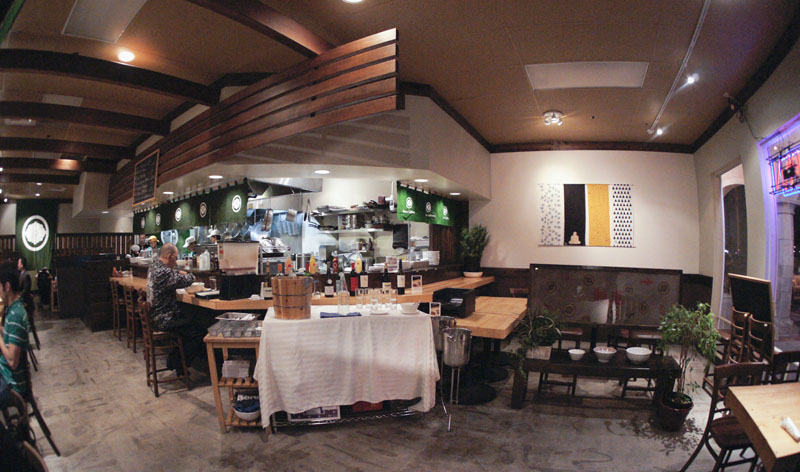

Ask a Bruin to describe ramen noodles, and the answer will include Costco, 29-cent packages and orange powder. It’s the sad answer to “What’s for dinner?” when dirt-poor meets haven’t-got-any-time. For a restaurant to specialize in ramen sounds about as ridiculous as one serving popcorn or Lean Cuisine.
Ask someone from Japan to describe ramen and the inevitable answer is, “What kind?” Boil-at-home ramen is merely a substitute for the bowls of fresh noodles and soup found at ramen restaurants, found in more than 20 varieties. Whether thick noodles or thin, heavy pork broth or light fish stock, a steaming bowl of ramen can create a time vacuum.
It’s easy to remember the hungry anticipation before ramen hits the table. And the afterward is just as memorable: the jolting realization that we”˜ve consumed every last noodle. It’s the time in between that always gets lost, when rational thought gives way to: “More soup. More noodle. More soup. More noodle.” Spread throughout Los Angeles are ramen stores of every variety.
Ramen California
One of Japan’s own superstar ramen chefs opened Ramen California with the goal of using a variety of vegetables and meat of the utmost quality to create a new California-style ramen. Despite my doubts, I tried the most seemingly odd choice on the menu ““ the Reggiano Cheese Tofu Ramen ““ complete with a smorgasbord of barely cooked vegetables in a light chicken broth. It looked nothing like what I thought traditional ramen was supposed to be. These vegetables were brightly colored, beautifully cut, and looked like they belonged more at a French restaurant than a Japanese one. Cauliflower and beets aren’t usually Japanese mainstays. But the rich Reggiano, reminiscent of a more sharply tasting brie, added depth to the simple soup and provided a foil to the unadorned vegetables. The experience resembles pinball ““ senses hit you first with fresh then rich, light then heavy, over and over again. Ramen California represents traditional ramen spirit brought across the ocean, lovingly, to a new home.
Santouka
A chain from the ramen motherland, no soup has as much porky essence as Santouka’s toroniku. In fact, this restaurant chooses to serve the accompanying pork slices, green onions, bamboo shoots and fish cake on the side. Of course you’ll add them ““ they’re delicious ““ but the bowl could easily stand tall with only soup and noodle in a beautifully minimalist union. It must require countless pounds of meat and bones to create what is undoubtedly the richest stock around town. As is often the case with skillfully prepared food, however, one can’t taste all the work and time that went into a single bowl. It tastes utterly simple. Maybe it’s not fair to compare. Santouka is the big, bad Japanese chain with lineage and financial backing to execute Japanese tradition to the letter of the law. But when Santouka is firing on all cylinders, simplicity has never tasted so good.
Daikokuya
If there were a holy text to the religion of Los Angeles dining, it would be Pulitzer Prize-winning writer Jonathan Gold’s yearly list, “99 Essential LA Restaurants.” As the only ramen restaurant mentioned on the list, Daikokuya is popular. Too popular. As in, if it’s 9:30 p.m. on a Wednesday, no one wants to wait an hour for their fix. It’s inhumane given that Daikokuya has the best slices of roast pork in town. The noodles have substantial body and heft. The soup, especially when fortified with pork fat to create the kotteri version, is rich, sweet and of the “just one more bite” variety. Furthermore, the accompanying bean sprouts, green onion and bamboo shoots provide lightness to create an all-around winner. Maybe one day, Jonathan Gold will do us a favor and take Daikokuya off his list.
Orochon Ramen
If “Fear Factor” continued to this day, a bug-eating challenge would be replaced by the Special 2 at Orochon Ramen. Instead of insects, its soup contains such an impossibly hot blend of peppers that I saw a man gasp, cringe and search for milk after just one sip. Others actually try to finish the bowl by the 30-minute deadline, with disastrous effect. Rumors float around about the soup. It allegedly contains ghost peppers, the strand of pepper several times hotter than the habanero chili. The owner has supposedly never even tried it. I steered away from the Special 2 but tried the considerably more manageable Special 1 and found that the peppers distracted from an already full-flavored base. The clear soup of the salt broth in another bowl, however, ordered with no spice at all, was the lightest I had tried in weeks. Refreshing, even ““ leave the spice bombs to the masochists.
